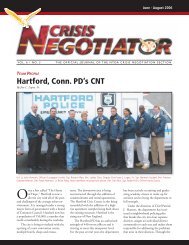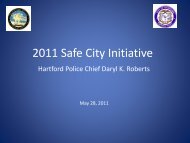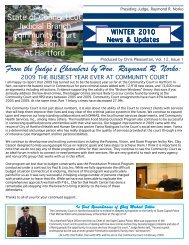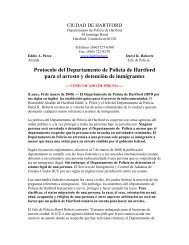What is Weed and Seed and what does it mean to your ...
What is Weed and Seed and what does it mean to your ...
What is Weed and Seed and what does it mean to your ...
Create successful ePaper yourself
Turn your PDF publications into a flip-book with our unique Google optimized e-Paper software.
<strong>What</strong> <strong>is</strong> <strong>Weed</strong> <strong>and</strong> <strong>Seed</strong> <strong>and</strong><strong>what</strong> <strong>does</strong> <strong>it</strong> <strong>mean</strong> <strong>to</strong> <strong>your</strong> neighborhood?<strong>Weed</strong> <strong>and</strong> <strong>Seed</strong>, a commun<strong>it</strong>y-based strategy sponsored by the U.S. Department of Justice (DOJ), <strong>is</strong>an innovative, comprehensive multi agency approach <strong>to</strong> law enforcement, crime prevention, <strong>and</strong>commun<strong>it</strong>y rev<strong>it</strong>alization. The Commun<strong>it</strong>y Capac<strong>it</strong>y Development Office oversees the <strong>Weed</strong> <strong>and</strong><strong>Seed</strong> in<strong>it</strong>iative.<strong>Weed</strong> <strong>and</strong> <strong>Seed</strong> <strong>is</strong> foremost a strategy—rather than a grant program—that aims <strong>to</strong> prevent, control,<strong>and</strong> reduce violent crime, drug abuse, <strong>and</strong> gang activ<strong>it</strong>y in the Upper Albany Clay Arsenalneighborhoods.The strategy involves a two-pronged approach: law enforcement agencies <strong>and</strong> prosecu<strong>to</strong>rscooperate in "weeding out" violent criminals <strong>and</strong> drug abusers <strong>and</strong> public agencies <strong>and</strong> commun<strong>it</strong>ybasedprivate organizations collaborate <strong>to</strong> "seed" much-needed human services, includingprevention, intervention, treatment, <strong>and</strong> neighborhood res<strong>to</strong>ration programs.A commun<strong>it</strong>y-oriented policing component bridges the weeding <strong>and</strong> seeding elements. Youth- <strong>and</strong>adult-oriented services are delivered. Through coordinated efforts, <strong>Weed</strong> <strong>and</strong> <strong>Seed</strong> joins varioustask forces of Law Enforcement Agencies from all levels of government who aim <strong>to</strong> reduce bothcrime <strong>and</strong> fear of crime, which gives back hope <strong>to</strong> residents living in d<strong>is</strong>tressed neighborhoods <strong>and</strong>sets the stage for commun<strong>it</strong>y rev<strong>it</strong>alization. Commun<strong>it</strong>y Policing embraces two key concepts—commun<strong>it</strong>y engagement <strong>and</strong> problem solving. Commun<strong>it</strong>y policing strategies foster a sense ofresponsibil<strong>it</strong>y w<strong>it</strong>hin the commun<strong>it</strong>y for solving crime problems <strong>and</strong> help develop cooperativerelationships between the police <strong>and</strong> residents.About <strong>Weed</strong> <strong>and</strong> <strong>Seed</strong>Catchment AreaStrategic GoalsSteering Comm<strong>it</strong>teeThe Prevention, Intervention, <strong>and</strong> Treatment component concentrates an array of human servicesin the UA/CA neighborhood <strong>and</strong> links law enforcement, social services agencies, the private sec<strong>to</strong>r,<strong>and</strong> the commun<strong>it</strong>y <strong>to</strong> improve the overall qual<strong>it</strong>y of services <strong>to</strong> residents. The UA/CA <strong>Weed</strong> <strong>and</strong><strong>Seed</strong> s<strong>it</strong>e has establ<strong>is</strong>hed Safe Havens, a mult<strong>is</strong>ervice center often housed in a school or commun<strong>it</strong>ycenter, where d use of federal, state, local, <strong>and</strong> private-sec<strong>to</strong>r resources, NeighborhoodRes<strong>to</strong>ration strategies focus on economic development, employment opportun<strong>it</strong>ies for residents,<strong>and</strong> improvements <strong>to</strong> the housing s<strong>to</strong>ck <strong>and</strong> physical environment of the neighborhood. The“<strong>Weed</strong>ing” component weeds out Crime, while the “<strong>Seed</strong>ing component, seeds the commun<strong>it</strong>yw<strong>it</strong>h social services <strong>and</strong> resource.Improve the qual<strong>it</strong>y of life in <strong>your</strong> commun<strong>it</strong>y by joining “<strong>Weed</strong> & <strong>Seed</strong>”. Contact Officer KevinO’Brien, <strong>Weed</strong> <strong>and</strong> <strong>Seed</strong> Coordina<strong>to</strong>r, at 860-757-4014 for more information.Do you want <strong>to</strong> see a CHANGE?Attend the <strong>Weed</strong> <strong>and</strong> <strong>Seed</strong> Steering Comm<strong>it</strong>tee meeting held the third Wednesday of every monthbeginning at 5 p.m. at The Art<strong>is</strong>ts Collective, 1200 Albany Avenue, Hartford
About <strong>Weed</strong> <strong>and</strong> <strong>Seed</strong>The Upper Albany/Clay Arsenal (UACA) s<strong>it</strong>e received <strong>Weed</strong> <strong>and</strong> <strong>Seed</strong> OfficialRecogn<strong>it</strong>ion from the Department of Justice/Office of Justice Programs on June 1,2005, <strong>and</strong> serves a combined population of 11,435 residents for these two Hartfordneighborhoods w<strong>it</strong>hin a .83 square mile area. The UACA <strong>Weed</strong> <strong>and</strong> <strong>Seed</strong> areaboundaries are as follows: Ann Street (east), Homestead Avenue (south), HomesteadAvenue <strong>and</strong> Westbourne Parkway (west), Westbourne Parkway <strong>and</strong> GreenfieldStreet <strong>and</strong> Mahl Avenue (north).The Upper Albany/Clay Arsenal (UACA) <strong>Weed</strong> <strong>and</strong> <strong>Seed</strong> Steering Comm<strong>it</strong>tee (WSSC)cons<strong>is</strong>ts of several members, <strong>and</strong> <strong>is</strong> headed by an Executive Comm<strong>it</strong>tee, which <strong>is</strong>composed of WSSC chairman Brian Leaming (U.S. At<strong>to</strong>rney’s Office appointee) <strong>and</strong>WSSC co-chairman HPD Captain Scott Sansom, UACA S<strong>it</strong>e Coordina<strong>to</strong>r (Officer KevinO’Brien) <strong>and</strong> the chairpersons of the <strong>Weed</strong> <strong>and</strong> <strong>Seed</strong> subcomm<strong>it</strong>tees.Members of the WSSC are responsible for strategic planning, policymaking, <strong>and</strong>management of the <strong>Weed</strong> <strong>and</strong> <strong>Seed</strong> project. The WSSC focuses on defining thev<strong>is</strong>ion for th<strong>is</strong> project, conducting <strong>and</strong> analyzing needs assessments, setting goals,establ<strong>is</strong>hing an evaluation plan, <strong>and</strong> maintaining viable subcomm<strong>it</strong>tees <strong>and</strong> workgroups <strong>to</strong> oversee daily operations.WSSC activ<strong>it</strong>ies also include policy development, creation of inter-agency procedures<strong>and</strong> pro<strong>to</strong>cols, project management, <strong>and</strong> advocacy. It in<strong>it</strong>iates program adjustmentsbased on progress reports. The WSSC mediates <strong>and</strong> resolves implementation <strong>is</strong>sues<strong>and</strong> coordinates cross-agency collaborations. Overall, the WSSC ensures thatweeding <strong>and</strong> seeding activ<strong>it</strong>ies are fully integrated, works on grant applications <strong>to</strong>obtain funding for programs, <strong>and</strong> oversees the work of the coordina<strong>to</strong>r <strong>and</strong> projectevalua<strong>to</strong>r.Catchment AreaStrategic GoalsSteering Comm<strong>it</strong>tee
<strong>Weed</strong> & <strong>Seed</strong> Strategic GoalsLaw EnforcementThe crime prevention efforts began in the Upper Albany/Clay Arsenal (UACA)neighborhoods in large part because of the increase in gun violence in these areas.The UACA <strong>Weed</strong> <strong>and</strong> <strong>Seed</strong> efforts continue <strong>to</strong> strive in reducing gun violence. Deeplyconnected w<strong>it</strong>h the gun violence <strong>is</strong> the narcotics trade, which <strong>is</strong> in fact most often thecause of the gun violence. Therefore, the law enforcement strategy also will continue<strong>to</strong> address narcotics sales in the UACA.Commun<strong>it</strong>y PolicingThe UACA <strong>Weed</strong> <strong>and</strong> <strong>Seed</strong> remains focused on creating a safer, more attractivecommun<strong>it</strong>y for residents, businesses, cus<strong>to</strong>mers, <strong>and</strong> v<strong>is</strong><strong>it</strong>ors. Law enforcementpersonnel are engaged by commun<strong>it</strong>y residents <strong>and</strong> businesses <strong>to</strong> find ways <strong>to</strong>improve the qual<strong>it</strong>y of life w<strong>it</strong>hin their commun<strong>it</strong>ies. C<strong>it</strong>izens will be mobilized <strong>to</strong> takecontrol of their home neighborhoods through an ongoing effort <strong>to</strong> increase c<strong>it</strong>izentraining.Prevention, Intervention, Treatment (PIT)In an effort <strong>to</strong> address underlying root causes of crime, <strong>Weed</strong> & <strong>Seed</strong> works <strong>to</strong>wardsdeveloping partnerships that can address the systemic problems in the UACA, such asdomestic violence <strong>and</strong> child abuse, poverty, lack of youth activ<strong>it</strong>ies <strong>and</strong> youthdirection, the difficulty of re-entry for offenders, easy access <strong>to</strong> guns, etc. Young menin the UACA in particular need <strong>to</strong> have establ<strong>is</strong>hed life goals <strong>and</strong> <strong>to</strong> believe that theycan find ways <strong>to</strong> support themselves <strong>and</strong> their young families through fulfilling workthat pays an adult wage. Extending the concern w<strong>it</strong>h youth <strong>and</strong> the young people inthe UACA, PIT strategies continue <strong>to</strong> focus on building collaborative partnerships <strong>to</strong>develop safe havens <strong>and</strong> “safe haven programs” in the commun<strong>it</strong>y, particularly afterschool<strong>and</strong> weekend youth activ<strong>it</strong>ies.About <strong>Weed</strong> <strong>and</strong> <strong>Seed</strong>Catchment AreaStrategic GoalsSteering Comm<strong>it</strong>teeNeighborhood Res<strong>to</strong>rationUACA neighborhoods are being mobilized. Merchants remain encouraged <strong>to</strong> clean upthe area surrounding their business <strong>and</strong> <strong>to</strong> take action <strong>to</strong> prevent crime. Youth will befurther engaged in activ<strong>it</strong>ies that promote neighborhood beautification <strong>and</strong> pride. Aprimary strategic goal <strong>is</strong> <strong>to</strong> enhance the qual<strong>it</strong>y of life in the UACA by reducingneighborhood d<strong>is</strong>order. Efforts have been ongoing <strong>to</strong> organize c<strong>it</strong>izens <strong>and</strong> businesseson public safety <strong>is</strong>sues, enhance the commercial streetscape, <strong>and</strong> <strong>to</strong> improve thecleanliness <strong>and</strong> appearance of the neighborhoods. Projects have been in<strong>it</strong>iated w<strong>it</strong>hc<strong>it</strong>y government that fund efforts <strong>to</strong> rev<strong>it</strong>alize neighborhoods w<strong>it</strong>hin the UACA,including improvements in facades, street lighting, <strong>and</strong> sidewalks.
















